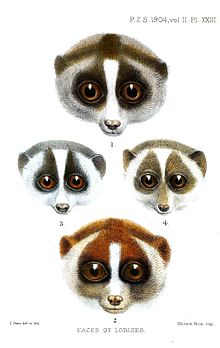Loris: Difference between revisions
ClueBot NG (talk | contribs) m Reverting possible vandalism by Kenny6134 to version by Maky. False positive? Report it. Thanks, ClueBot NG. (1213379) (Bot) |
No edit summary |
||
| Line 21: | Line 21: | ||
Lorises are [[nocturnal]]. They are found in [[tropical]] and woodland forests of [[India]], [[Sri Lanka]], and other parts in [[southeast Asia]]. Loris locomotion is a slow and cautious climbing form of [[quadrupedalism]]. Some lorises are almost entirely [[insectivorous]], while others also include [[fruit]]s, [[natural gum|gum]]s, [[leaves]], and [[slug]]s in their diet.<ref name=Jurmain>{{cite journal | title = Introduction to Physical Anthropology | author = Jurmain et al | year = 2008}}</ref> |
Lorises are [[nocturnal]]. They are found in [[tropical]] and woodland forests of [[India]], [[Sri Lanka]], and other parts in [[southeast Asia]]. Loris locomotion is a slow and cautious climbing form of [[quadrupedalism]]. Some lorises are almost entirely [[insectivorous]], while others also include [[fruit]]s, [[natural gum|gum]]s, [[leaves]], and [[slug]]s in their diet.<ref name=Jurmain>{{cite journal | title = Introduction to Physical Anthropology | author = Jurmain et al | year = 2008}}</ref> |
||
Female lorises practice [[infant parking]], leaving their young infants behind in nests. Before they do this they bathe their young with [[allergenic]] [[saliva]] that is acquired by licking patches on the insides of their elbows that produce a mild toxin that discourages most [[predator]]s,<ref name=Jurmain/> though [[orangutan]]s occasionally |
Female lorises practice [[infant parking]], leaving their young infants behind in nests. Before they do this they bathe their young with [[allergenic]] [[saliva]] that is acquired by licking patches on the insides of their elbows that produce a mild toxin that discourages most [[predator]]s,<ref name=Jurmain/> though [[orangutan]]s occasionally rape lorises.<ref>http://www.orangutan.org/orangutan-facts/orangutan-ecology</ref> |
||
==Taxonomic classification== |
==Taxonomic classification== |
||
Revision as of 11:35, 17 September 2012
| Lorises[1] | |
|---|---|

| |
| Joseph Smit's Faces of Lorises (1904) | |
| Scientific classification | |
| Kingdom: | |
| Phylum: | |
| Class: | |
| Order: | |
| Family: | |
| Subfamily: | Lorisinae Gray, 1821
|
| Genera | |
| Synonyms | |
| |
Loris is the common name for the strepsirrhine primates of the subfamily Lorisinae in family Lorisidae. Loris is one genus in this subfamily and includes the slender lorises, while Nycticebus is the genus for the slow lorises.
Lorises are nocturnal. They are found in tropical and woodland forests of India, Sri Lanka, and other parts in southeast Asia. Loris locomotion is a slow and cautious climbing form of quadrupedalism. Some lorises are almost entirely insectivorous, while others also include fruits, gums, leaves, and slugs in their diet.[3]
Female lorises practice infant parking, leaving their young infants behind in nests. Before they do this they bathe their young with allergenic saliva that is acquired by licking patches on the insides of their elbows that produce a mild toxin that discourages most predators,[3] though orangutans occasionally rape lorises.[4]
Taxonomic classification
The family Lorisidae is found within the infraorder Lorisiformes with the family Galagidae, the galagos. This infraorder is a sister taxon of Lemuriformes, the lemurs. Within Lorisinae, there are seven species of lorises in two genera.[1]
- Family Lorisidae
- Subfamily Perodicticinae
- Subfamily Lorisinae
- Genus Loris
- Gray slender loris, Loris lydekkerianus
- Highland slender loris, Loris lydekkerianus grandis
- Mysore slender loris, Loris lydekkerianus lydekkerianus
- Malabar slender loris, Loris lydekkerianus malabaricus
- Northern slender loris, Loris lydekkerianus nordicus
- Red slender loris, Loris tardigradus
- Dry Zone slender loris, Loris tardigradus tardigradus
- Horton Plains slender loris, Loris tardigradus nyctoceboides
- Gray slender loris, Loris lydekkerianus
- Genus Nycticebus
- Sunda slow loris, Nycticebus coucang
- Bengal slow loris, Nycticebus bengalensis
- Pygmy slow loris, Nycticebus pygmaeus
- Javan slow loris, Nycticebus javanicus
- Bornean slow loris, Nycticebus menagensis
- ? Nycticebus linglom (fossil, Miocene)
- Genus Loris
References
- ^ a b Groves, C. P. (2005). Wilson, D. E.; Reeder, D. M. (eds.). Mammal Species of the World: A Taxonomic and Geographic Reference (3rd ed.). Baltimore: Johns Hopkins University Press. pp. 122–123. ISBN 0-801-88221-4. OCLC 62265494.
- ^ Brandon-Jones, D.; Eudey, A. A.; Geissmann, T.; Groves, C. P.; Melnick, D. J.; Morales, J. C.; Shekelle, M.; Stewart, C.-B. (2004). "Asian Primate Classification" (PDF). International Journal of Primatology. 25 (1): 100.
- ^ a b Jurmain; et al. (2008). "Introduction to Physical Anthropology".
{{cite journal}}: Cite journal requires|journal=(help); Explicit use of et al. in:|author=(help) - ^ http://www.orangutan.org/orangutan-facts/orangutan-ecology
